South West Airfields Heritage Trust
“Preserving Aviation History for Future Generations”




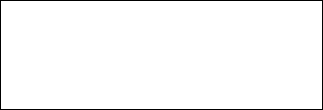
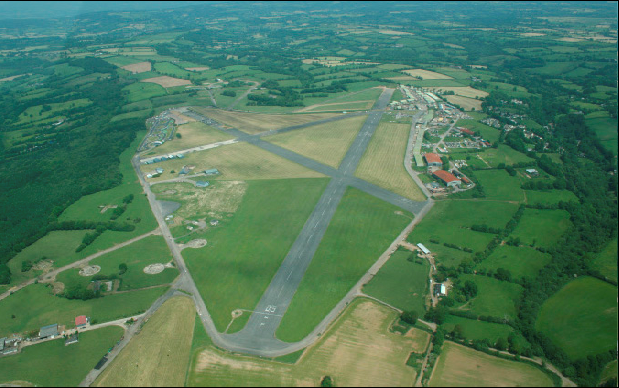
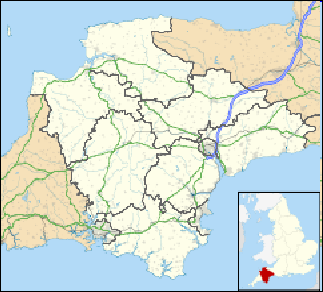

Although some 366 miles from the centre of the Bay of Biscay, Dunkeswell airfield owes its origins to the urgent need to tackle the threat created by the German U-
The Battle, although overshadowed by the Battle of Britain and D Day, pitted U-
When France fell in June 1940, the Germans improved their prospects even more, as they took possession of French naval bases along the Atlantic coast converting them in to Impenetrable U boat bases See Map below.
T
The first French U-
This also created a serious problem for the RAF’s Coastal Command, for not only did they lack the Aircraft and weapons capable of attacking Submarines. They also lacked Airfields in the South West of England from which they could operate to intercept U boats operating from these new bases.
As a result the Kriegsmarine or German navy began to operate with virtual impunity to the extent by the Autumn of 1941 the U boat or Submarine threat had become so serious to Britain’s survival that it was decided to urgently construct special advanced bases in the South West of England .
AIRFIELD HISTORY
Location Dunkeswell Nr Honiton, Devon Opened 1943
In use 1943 to 1945 -
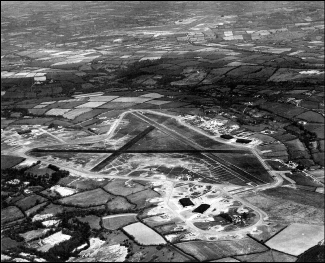


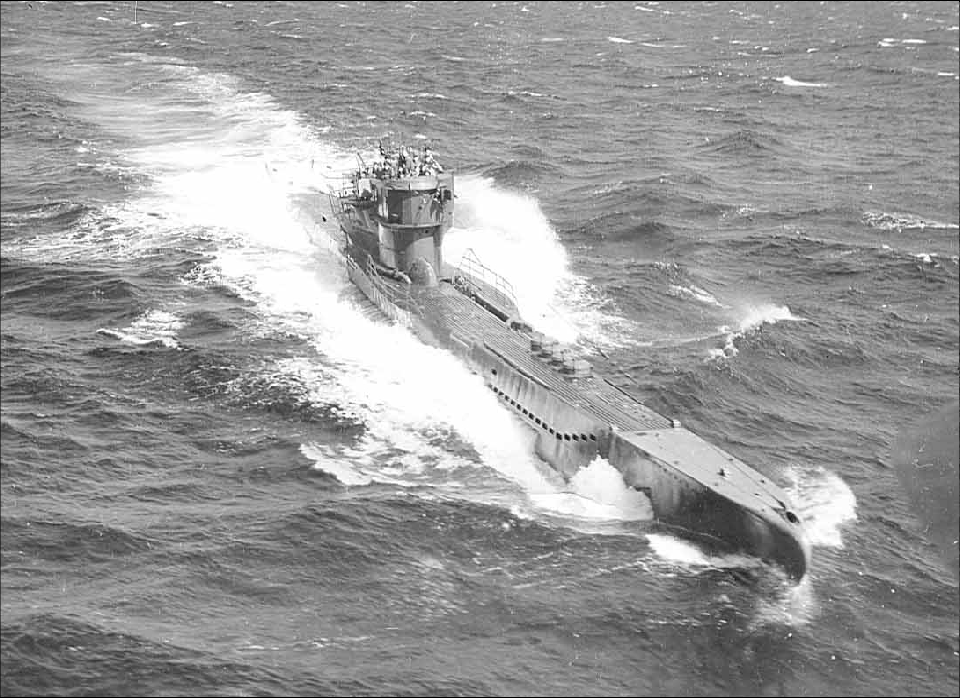
U 278 -
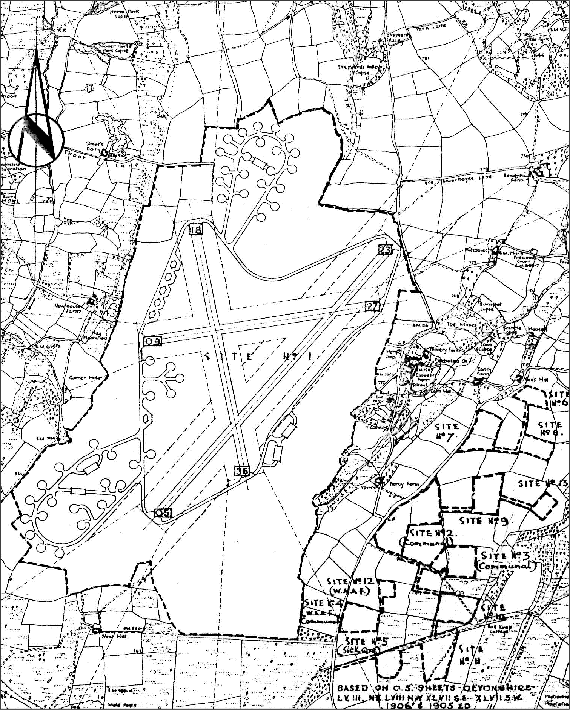
Construction
Following a survey of potential sites it was decided that one of the new airfields should be constructed at Dunkeswell which was 850 feet above Sea Level, and was on a relatively level plateau.
Land was requisitioned from a number of farms under the Emergency Powers (Defence) act of 1939.
The Airfield was built to the war time RAF Standard Class ‘A’ operational airfield design for all contemporary heavy bombers
Three Runways, 50 yrds wide were built, with main Runway 05/23 being 200 yrds long and runway’s 18/36 being 1470 yrds & 09/27 being 1,270
Initial construction of the Airfield was started in early 1942. with the airfield being completed on June 26th 1943, at a cost £1,107,000 and was undertaken by George Wimpey and Co with mainly Irish, Ministry of Works Labour.
Although following the arrival of the US Navy in September 1943 additional construction work was carried out by the US Navy Sea Bees on and around the base, from February 1944 virtually right up until the Airfield was handed back to the RAF in August 1945.
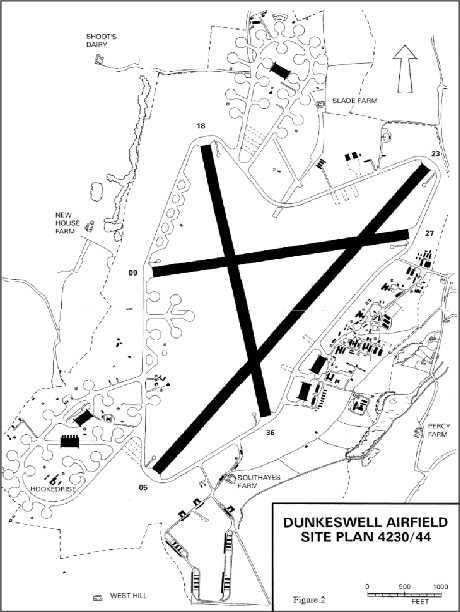

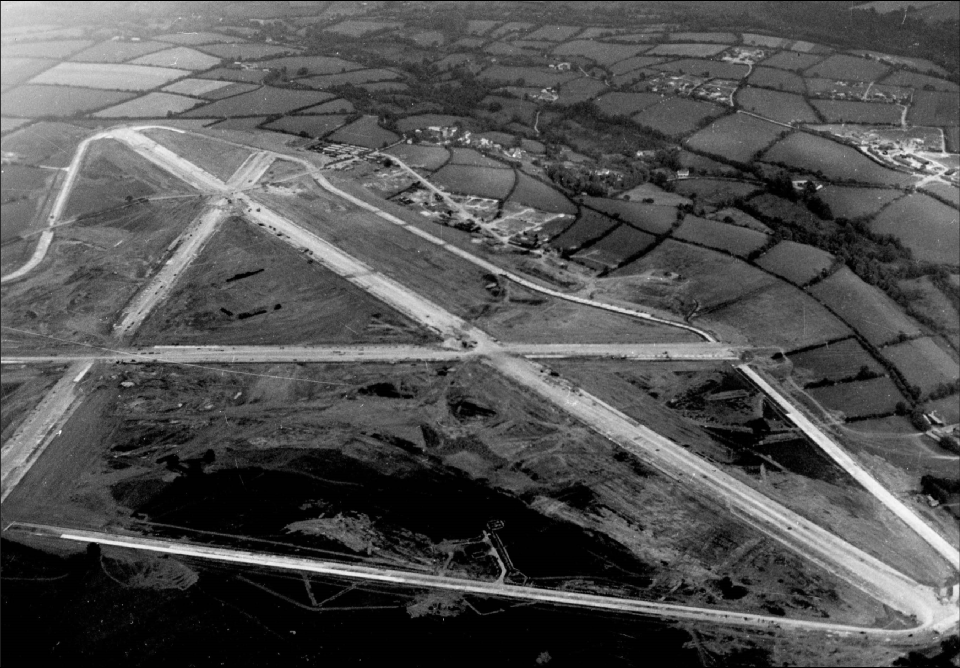
Dunkeswell under Construction. This was taken on the 18th September 1942. Just 7 months after work commenced. Note; There are no hangars or control tower at this stage of construction and that the runways have not yet been sprayed with Tarmac. Runways were normally Tarmacced to reduce visibility from the air.
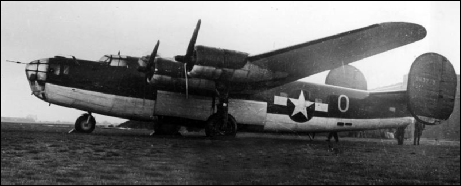
“White Savage” 42 40921 M is a 479th Anti-
An Early 479th B24 D with A “Green House” Nose. Note how the Fuselage is a simple two tone colour The top half being Olive Green with White below Later Aircraft were painted in a Sea search finish
479TH Anti-
Although the Airfield had been allocated and subsequently handed over to RAF 19 Group Coastal command under the command of Group Captain EC Kidd, it was the American 479th Anti-
These Squadrons had been formed on the 1st July 1943 from existing US Army Air forces Anti Submarine units or the 25th Antisubmarine Wing at Langley field Virginia and been activated under Col Howard Moore on the 8th July 1943, some of whom had been operating from Gander in Newfoundland.
Following their success in driving out the U boats from the north Atlantic, it had been agreed that these units and others would be formed into the 4th , 6th 19th & 22nd Squadrons of a new group be known as 479th Anti-
So it was this group arrived, firstly at St Eval, in Cornwall in early July 1943 and then to Dunkeswell a month later with the first Squadrons, the 4th and 19th arriving at Dunkeswell on Friday 6th August , the 22nd on Friday the 20th August and the 6th on Saturday the 21st August.
There the 479th Group had the facility to itself, although at first it was dependent on a good deal of RAF ground support, while the station commander, Group Captain Kidd, exercised a general supervision of the Airfield. Colonel Moore was largely free to operate as he wished.
In addition the 87th Service Squadron, the 1813th Ordnance Service and Maintenance Company, the 1177th Military Police Company, and the 444th Quartermaster Platoon were also assigned to help the squadrons.
As result Dunkeswell became a mix of both RAF and US Personnel with the RAF supplying administrative and initial maintenance support .
Although Dunkeswell had been officially handed over to the RAF it was still incomplete, (See Picture to the Right and above) particularly with regard to the off-
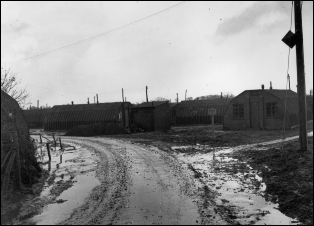
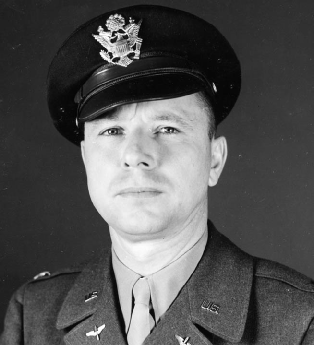
Colonel Howard Moore
Commanding officer of the
USAAF 479th Anti -
The first group to fly from Dunkeswell
Mud Glorious Mud ! Here is a picture of one of the dispersed living sites. Showing Why the US Navy Personnel later referred to the base as Mudville Heights !!
Anti– Submarine Operations Commence
Within a day of arriving, Operations began from Dunkeswell, unfortunately this coincided with Admiral Dönitz head of the Kriegsmarine, changing his tactics from one, where he had instructed his U boats to take on and fight the Anti-
Missions
Most of the groups Missions involved B24,s flying out into the Bay of Biscay on a prescribed flight plan with the intentions to attack U boats travelling on the Surface to and from their bases. Contrary to myth propagated by film and media most U boats would travel on the surface using diesel engines and submerging only when they were attacked or in danger.
A U boat could travel at around 17 knots on the surface and only about 6 knots submerged on its batteries.
So Coastal Command devised patrol areas called grids where Aircraft would literally fly a prescribed route that meant that the Aircraft together with others in the area would fly over the same stretch of water every 20 to 30 minutes to enable them to spot any U boat either travelling or surfacing to re charge its batteries.
Patrols were timed so that the Aircraft was in its patrol area by summer daybreak, crews would wake and be turned out as early as 3 am, when they would be taken to the mess Hall for breakfast by van or truck in complete darkness.
They would attend a flight briefing at the operations block,. This would consist of the flight pattern for the day, Weather, anticipated U boat and Luftwaffe Movements in their sector and reports on enemy activity in the previous 24 hour period. Although the source was not known at the time Coastal command was receiving daily intelligence reports from Bletchley Park called “forms green” advising them of enemy activity for that day. Such was the success of the Code Breaking Operation known as Ultra, that crews naturally believed that this was being obtained by spies or from the resistance.
Once briefed the crew would then embark on the mission flying up to 10 hours in length Although with briefings and debriefings this could be extended by Two to Three hours. Meaning 12 to 13 hours was quite common before they were finished.
C
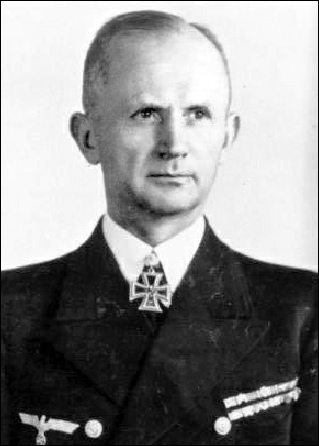
Rear Admiral Karl Dönitz
Head of the Kriegsmarine
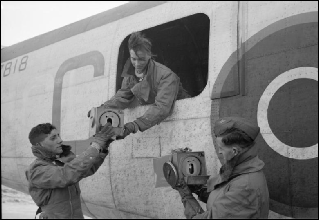
53 Squadron RAF handling carriers containing homing pigeons at St Eval, Cornwall.after a patrol over the Bay of Biscay. The 479th also carried Pigeons in their Aircraft
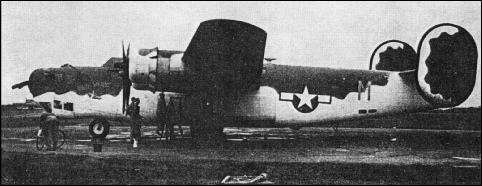
Once breakfast was over the crews would then collect their personal and aircraft equipment for the flight. Including Homing pigeons for use in emergency !
These were picked up in their cage before each flight and returned following landing. They were useful for two purposes: to relay messages that were not time-
A crash landing at sea, particularly if the radio operator had not been able to get off a message informing base of the crew's situation and location, was the prime opportunity for the homing pigeons to be of service. It assumed, of course, that the pigeons survived the crash landing, when their fate was not likely to be uppermost in the minds of the crew.
In their less critical use, the pigeons had to be released into the plane's slipstream, apt to be quite turbulent. Further, the airspeed of the B-
If a message was to be sent back during flight, it would be attached to the bird and then the pigeon was stuffed into the bag, head first, of course. One of the gunners at the waist window would carefully set the package outside. The closed end of the bag would be placed into the wind and in this way it was supposed to prevent the wind from stripping the bird's feathers off so quickly. As the package slowed down the pigeon was supposed to free himself and take off in the desired direction.
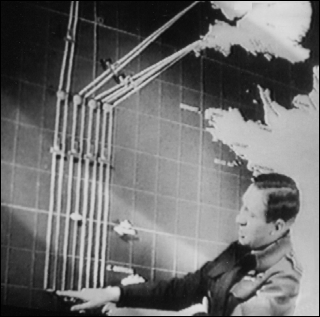
An RAF Officer outlines a typical Patrol Grid
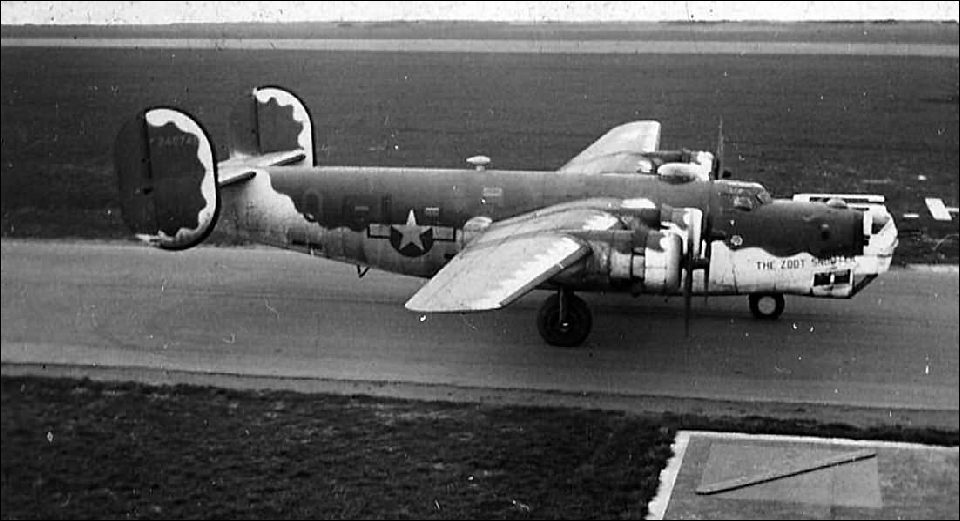
B24 D 42-
Crews were often on a 3 or 4 day cycle, where they would spend time preparing the Aircraft, and the following day, flying the mission. This would be followed by a day of rest then a day or two undertaking training.
Often missions could be literally flying countless hours without sighting or meeting the enemy, with the biggest enemy being boredom or an attack by JU88’s with their 20mm cannons who would often attack in multiples of 6-
But the Liberators could be a deadly threat to any unsuspecting U boat travelling on the Surface when without warning the Liberator would spot the u boat on the surface with its Radar and suddenly swoop in at between 100 and 250 feet dropping its lethal depth charges
The long missions over the bay imposed their own tempo and their own stress on the aircrews. Each crew hut on the field at Dunkeswell held the enlisted personnel of two aircrews, six on each side of the hut. As most of the group's ASW flights were timed to be in the patrol area by summer daybreak, this meant being turned out as early as 3am, with the aircrew then being "taken to a mess hall for a meal,."
After breakfast, the crew also picked up at the mess hall their "picnic lunch" for the long upcoming flight. Next came the flight briefing, followed by checking out OFF all personal and aircraft equipment essential to the flight.
The plane would normally be airborne for about 10 hours, then back to the base and go through the whole thing in reverse. The whole operation would take about twelve to fifteen hours and the crew would be ready to hit the sack when they had returned.
479th Leave the Battle
Then just as they were settling in, the Army Airforce, and in agreement with the US Navy, handed over Anti Submarine hunting to the US Navy in October 1943, just 2 months after they had arrived, with most of the 479ths aircrews being sent into VIII Bomber Command for the purposes of developing a Pathfinder force for the American Strategic Bombers, who then took part in the daylight bombing of Germany.
Interestingly Aircraft and personnel of the 22nd Squadron went to what would become known as the famous “Carpet Baggers” at RAF Harrington in Northamptonshire, who delivered supplies and agents to resistance groups in occupied France.
Despite there brief existence and a change in tactics from Admiral Dönitz the 479th had flown from St Eval and Dunkeswell a total of 452 patrols made 12 sightings, delivered 8 attacks and Shared 3 U boat kills, losing 5 aircraft in the process with 9 damaged.
Hunters become the hunted
During the summer and early Autumn of 1943 the Luftwaffe became a lot more active in the bay of Biscay than ever before in an effort to stem the serious losses that Allied Aircraft were taking and began to take a serious toll of the Allied Anti-
By the time the 479th had arrived at Dunkeswell the Hunters had indeed become the hunters and as U boat losses were reduced, losses of Anti-
It is not hard to understand why. Just as a U boat made a large and clumsy target for the Anti-
As a result the luftwaffe’s campaign became a deadly threat indeed Lt Grider from the 19th Squadron was attacked by 9 Ju88’s on the 7th August escaping without damage and on the 8th August the second day of operations from Dunkeswell Lt Rueben Thomas Aircraft, again from the 19th Squadron was lost without any survivors
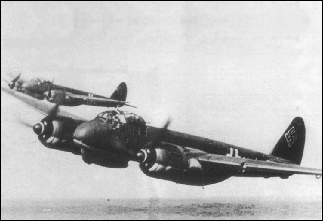
A Ju88c Medium Bomber
US Navy
Background to Handover.
By early 1941, Great Britain was losing the Battle of the Atlantic and, with the real prospect of the United States being drawn into the conflict, the U.S. Navy began devising a plan to protect the Atlantic sea lanes. Although it would go through the same learning curve that Coastal Command had gone through at the beginning of the War primarily because of the US Navy’s reluctance to accept advice from the British about placing ships in to convoys
Moreover and like coastal command it would also suffer from a lack of suitable Aircraft to the extent that Admiral Ernest King Head of the Navy had been required to reluctantly ask the Army Airforce to help defend the East coast of America when U boats had appeared in January 1942.
As a result a bitter inter service rivalry developed between the US army Airforce, ( USAAF ) , who having been tasked with dealing with the U boat until the Navy could obtain Aircraft , not only pioneered Anti Submarine Warfare but also believed that the best way to counter the U boat was to hunt them down with dedicated ASW Squadrons using long range Aircraft Such as the B17 and the New B24 Liberator.
In addition the USAAF introduced dedicated ordinance such as depth charges and Radar and drove the U boat back into the north Atlantic.
Following this success, a bitter “turf” dispute began between Admiral King and General Hap Arnold head of the Army over who should undertake Anti Submarine War fare (ASW).
The Navy believing this was a naval task and ultimately the responsibility of the Navy and the Army believing that as they had been tasked with undertaking this, and that as they had been successful, they should carry on with task and not have to report to the Navy any more !
This dispute rumbled on from early 1942 until June 1943 and formed part of a larger dispute about whether the Army Airforce should be a separate organisation similar to the RAF. Something that would not be resolved until after the war.
However in June 1943 the dispute was resolved when the Army Agreed that if the Navy handed over it’s Boeing production facility at Renton in Washington, that the Navy had lined up for the production of the new XPBB Super Ranger Aircraft. Then USAAF could build the new B29 Super fortress and in return would withdraw from ASW, they would also handover heir modified B24 Aircraft direct to the navy so the Navy could undertake the task, in return for standard B24’s that could be used for bombing.
As a result in June 1943 the Army Airforce received orders to begin handing over all ASW activities to the US Navy and in Great Britain, to Fleet Airwing 7 Although the Army in contradiction to the original agreement still kept some of their B24’s. resulting in the navy purchasing New B24’s Now be designated PB4Y’-
In Addition USAAF agreed to stay on until the US Navy had become familiarised with Coastal Commands requirements hence the decision for the USAAF still to come to Dunkeswell.
These Pictures below shows U boats being depth charged and illustrate the method of Attack

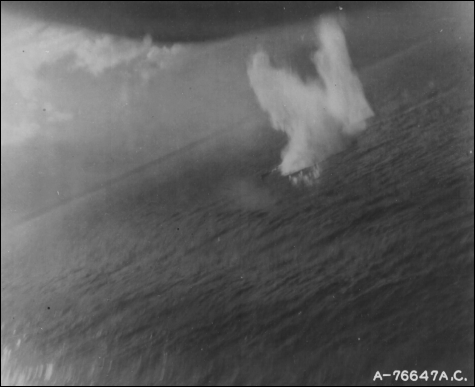
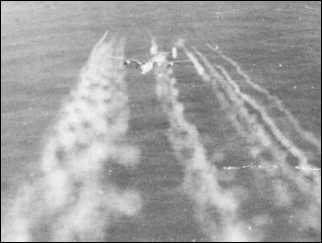
This Picture to the right is taken from gun camera film of a JU88 attacking an RAF Liberator similar to those flown by the 479th in the Bay of Biscay and by Luftwaffe Squadron V/KG.40 Note This is from just one JU88 ! Most attacks comprised of up to 8 Enemy Aircraft and sometimes 10 to 12 Indeed one Attack consisted of 14 !
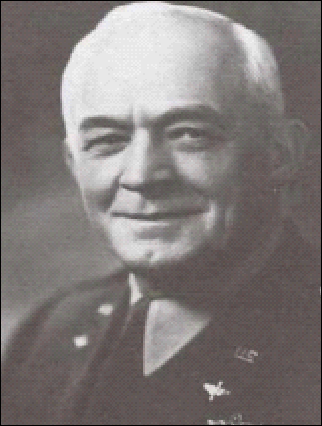
Gen. "Hap" Arnold
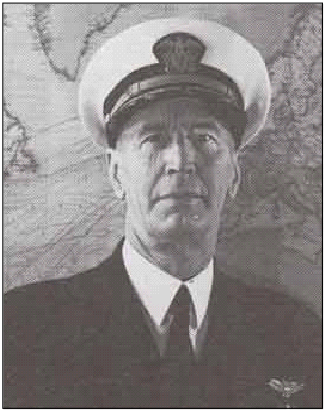
Adm Ernest J King
Fleet Airwing 7
In March 1941, out of this necessity to conduct proper aerial and surface observation of the waters off the eastern seaboard, the U.S. Navy organized the predecessor to Fleet Air Wing-
The establishment of the patrol wing would, two years later, give rise to the first Navy B-
For the next nine months, U.S. Navy Patrol Squadron’s (VP) 51,52,53, 55, and 56 (equipped with such aircraft as the Consolidated PB Y-
On 17 May 1941, Fleet Admiral Ernest J. King, Chief of Naval Operations, issued orders to the commanding officers of the Atlantic and Pacific Fleets, which ordered a reorganization of Patrol Plane Wings, This reorganization split the Support Force into two wings: Patrol Wing 7 and Patrol Wing 8.
In May 1942, Patrol Wing-
B24 Liberator
With a length of 67 feet, a wingspan of 110 feet, and a gross weight of 60,000 pounds. The Liberator was an imposing monster for the time. Powered by four Pratt and Whitney R-
The first Navy Liberators varied little from the Army B-
The bow turret had twin .50-
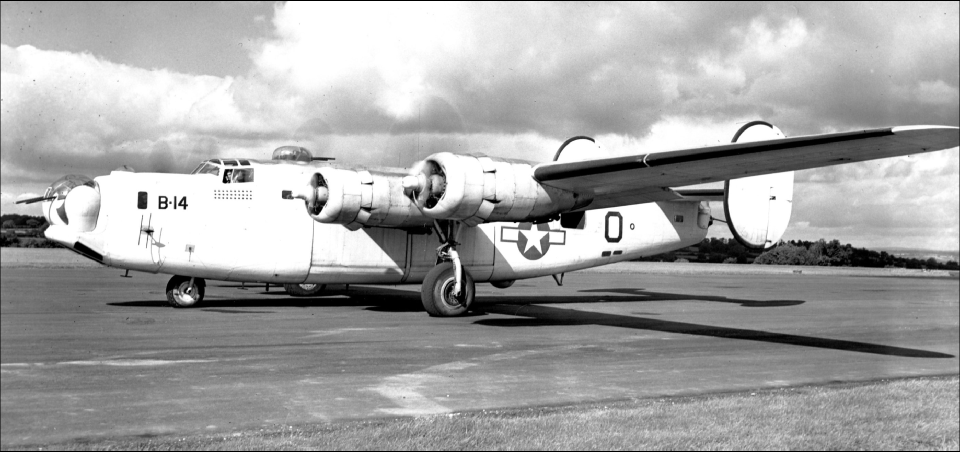
B14 “O “ Bu-
Birth of the Dunkeswell Air Group and US Naval Air Facility
With the decision made to handover Anti Submarine hunting to the US Navy. Orders were issued in Mid August 1943 to transfer Naval Squadrons from the Argentia Air Group, based in Newfoundland to the South West of England firstly to St Eval for training and then on to Dunkeswell. 3 of these Squadrons, VB 103, 105 & 110,* were then sent to Dunkeswell together with a Headquarters Squadron ( Hedron 7) to relieve the AAF 479th squadrons, who would then transfer to the 8th Army Airforce.
* The V being the Navy designation for fixed wing aircraft, VB would later become VPB (Navy Patrol Bomber on the 1st October 1944.) The first Naval Squadron to arrive at Dunkeswell, was VB 103 on the 30th September 1943, with VB105 on the 12th October, and VB 110 on the 22nd October.
Following training, Squadrons gradually moved over to Dunkeswell from the established base at St Eval in Cornwall . However as previously mentioned conditions on the base, left, much to be desired, During the winter, intermittent drizzle, occasionally whipped into a solid wall of water by wind, made it almost impossible to stay dry. The continuous sea of mud at Dunkeswell gave rise to the nickname of “Mudville Heights” and because of rain, sleet, snow, low ceiling, and poor visibility, a considerable number of returning flights had to be diverted to other airfields.
One of the initial problems that had been encountered ,firstly by the USAAF and then the US Navy, was the fact that the initial secondment to Coastal Command had been deemed by the US Government as “ temporary “. Until November 1st 1943 and then subsequently the 1st January 1944. As a result the Americans had accepted the British assurance that maintenance support would be provided by them and had decided not to bring any support with them. Leaving their own ground echelons back home in the states. They had also obtained support from the US army 8th Airforce based in Britain and considered that this would suffice due to the anticipated short stay.
However this immediately caused a number of problems, firstly the RAF had its own supply problems and operated quite differently to the US forces, In addition the RAF lacked the equipment for undertaking major overhauls of the Aircraft and also the skilled personnel to under take them. Standards of sanitation and housing and messing were also considered to be poorer than the US Navy Standards by their Medical officers So this meant that the Navy had to draw more and more from the Army Airforce both in Britain and from the States.
As time progressed it also became clear that the “temporary” assignment would be more long term and in December 1943 the Us Navy decided to set up its own Naval Air facility at Dunkeswell and became the only US Navy Facility outside of the United States.
This decision led to a major investment in the base and a major building programme with upgrades to the messing facilties, accommodation, roads and infrastructure. To bring the base up to US standards most of which was carried out by the US 97th and 69th Sea bees.
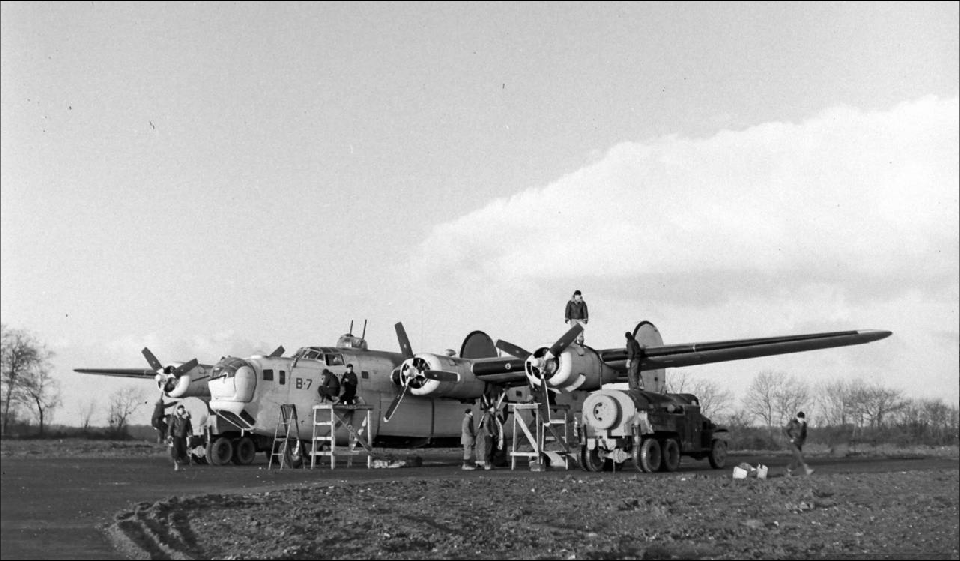
An aircraft is prepared for a mission
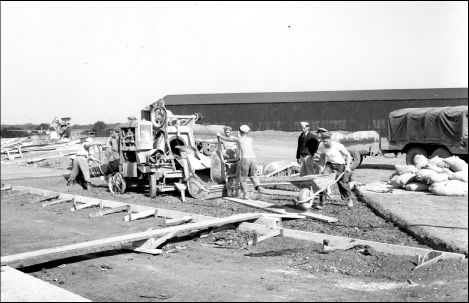
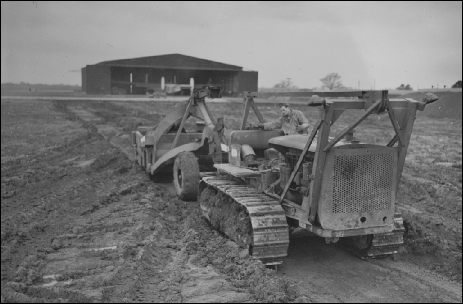
Above and right Sea Bees working at Dunkeswell
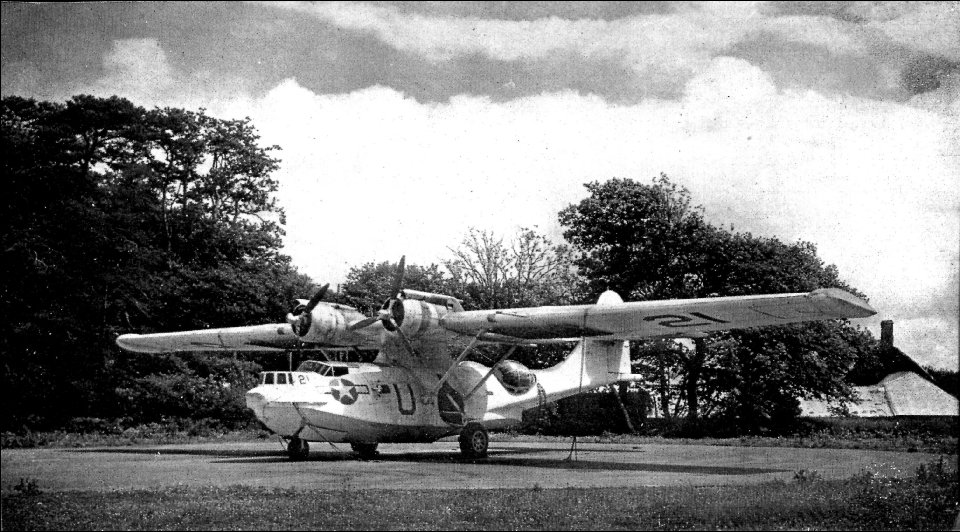
U 34047 21 one of the 4 Aircraft based at Dunkeswell from squadron VPB 63
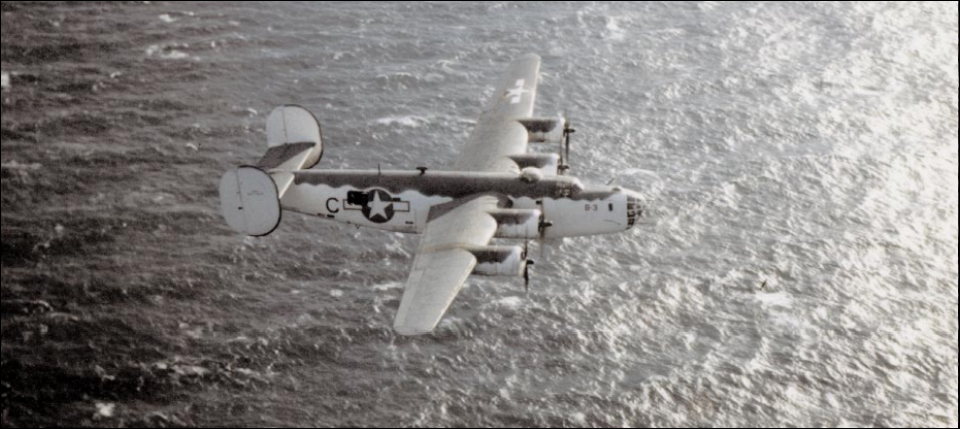
Calvert & Coke on Patrol VPB 103
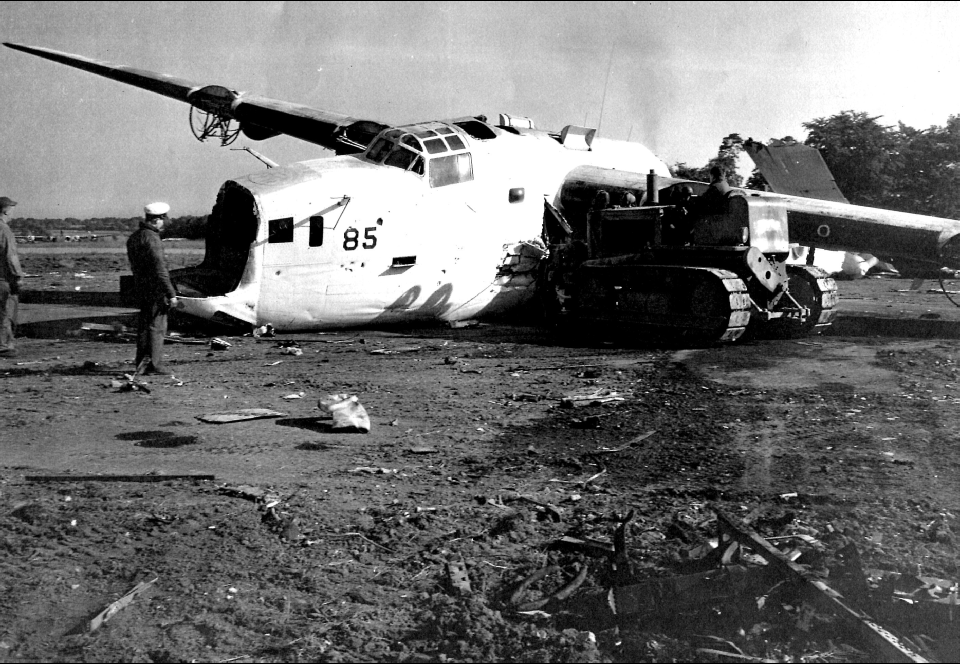
End of the Line !! No longer required or useful PB4Y-
Summary
The US Navy flew its first mission from Dunkeswell on 30th September 1943 and its last on the 28th May 1945 when orders to cease operations was given by Coastal Command.
During this period it found and attacked 65 U boats, sinking 7 and damaging another 11. They also took the Surrender of another 5 at a cost of 23 Aircraft & 178 men.
The last PB4Y-
Post War
Following the departure of the Navy the airfield was subsequently used as a short term base within 46 Group Transport Command for No. 16 Ferry Unit (RAF).
This unit was engaged in preparing and despatching a wide variety of British military aircraft to units in the Middle East and also to the newly reformed French Air Force. Also in August 1945 No. 11 Ferry Unit arrived from Talbenny in Pembrokeshire when this airfield closed. This activity continued until 26th April 1946, whereupon military flying ceased for a while with the airfield used as an RAF storage site.
This activity continued until December 1948 when the Technical Site was taken over by the Home Office as a Buffer Depot storing among other equipment. Green Goddess fire engines !!
On 19th November 1951 No. 208 Advanced Flying School was formed at Merryfield with Vampire T.ll and Meteor T.7s, and Dunkeswell was used as a satellite airfield from 1952 until 1955.
During the 1960s an RAF Radar Tracking unit was based here and used the Control Tower as accommodation. In March 1966 Captain J N A Goldsworthy, Royal Marines founded the Royal Marines Parachute Club, which in later years became known as RN&RM Sport Parachuting Association. Using the Control Tower as a Clubhouse from 1966.
Today the Airfield is active Private Airfield operated by Air Westward Ltd Devon & Somerset Flying School ( Link) Skydive Buzz( Link) both of whom kindly support our organisation.
Tours of this Airfield are available through SWAHT See Airfield Tours & Talks Link
Further information on Dunkeswell and the activities that took place there during WW2 can be obtained from the following links

Sources of information, Text & Photographs
-
-
-
-
During WWII -
-
-
-
-
-
-
-
-
-
-

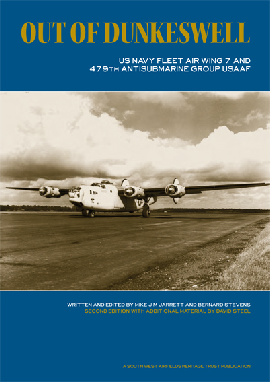
Out of Dunkeswell' describes in detail the role played by the airfield and the USAAF anti-
Southwest Airfields Heritage Trust © 2017
These bases could then be used to attack the U boat’ s based in Western France as well as by patrol Aircraft of Coastal Command . (See Map to the left showing Dunkeswell in relation to The Bay of Biscay)